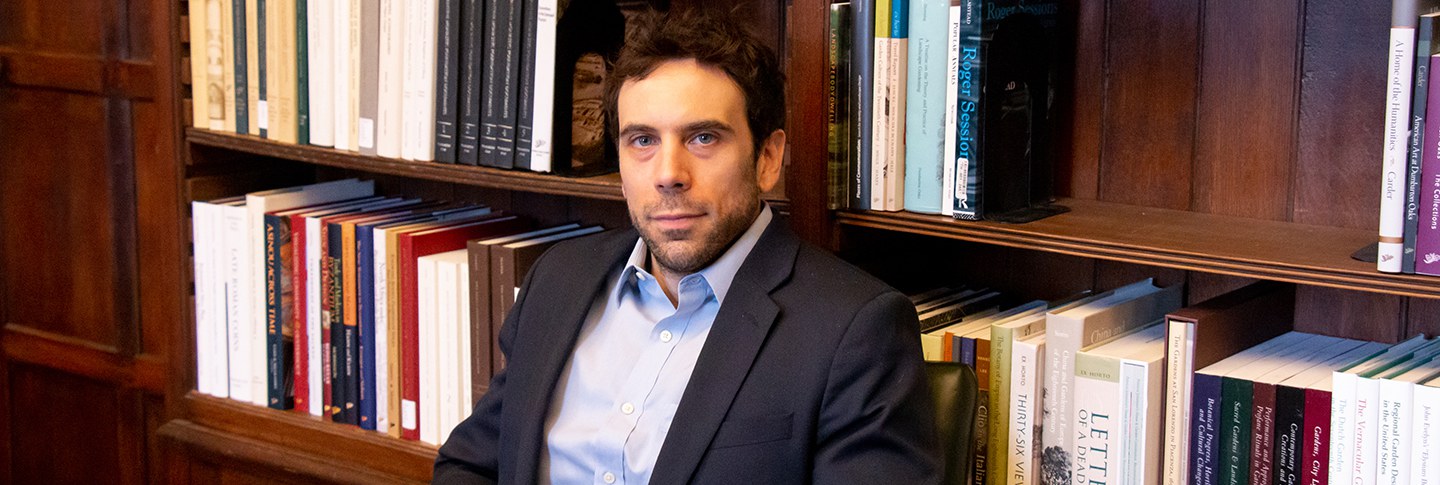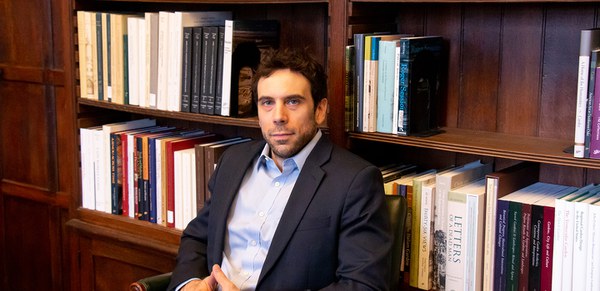Emanuel Fiano, assistant professor at Fordham University, is a fellow in Byzantine Studies. His research report, “The Ends of Dialogue: Religious Intolerance and the Parting of the Ways between Judaism and Christianity in Late Antiquity,” approached the separation between late ancient Christianity and Judaism through their elites’ respective citation practices.
Q&A with Emanuel Fiano
What are the forms of dialogue and intolerance you have studied in late antique Christianity and Judaism?
So, in my report I tried to distill a meaningful difference in relation to how the two traditions approached citation. If we admit it’s possible to look at some of Jews’ and Christians’ intellectual practices through this filter, we can see them engaged in different ways of citing the words of their predecessors.
I should mention that comparing these two bodies of literature (the Babylonian Talmud and the Greek and Latin Christian theological corpus) is an imposition, in a sense, because they were produced in different geographic contexts. But what counts here is that retrospectively those two corpora became fundamental literary and religious references for Jews and Christians respectively.
For Christian theologians, citing largely involved use of the so-called patristic argument, which is invoking the authority of past authors to validate one’s point. By contrast, in the Talmud, opposing citations from Amoraic times—the period between the third and sixth century when Jewish scholars interpreted statements about the Torah made by earlier scholars called the Tannaim—were incorporated into the text to construct the argumentation itself. Citations were shifted around, their original context was largely lost, and they were used as counterpoints to one another, even when they had not been originally produced in mutual connection. The editors of the Talmud created a new text and, in fact, a new discourse, by interweaving Amoraic citations to advance their own argumentative or even just literary agenda.
Through their practices of citation, both church fathers and Jewish rabbis expressed not only their views about their traditions’ relationship with the past, but also their sense of the extent to which different voices within the tradition should be accommodated. In my report I suggested that a study of these citation practices can help us reconstruct the difference between how a certain intolerant attitude installed itself in the two traditions. The prevailing narrative is that rabbinic Judaism was more polyphonic than Christianity. We can complicate this by showing how the rabbis were intolerant of different methodologies—what I have called monology—while Christians were intolerant of different beliefs—what others before me have called monodoxy.
What other aspects of early Christianity are you studying?
The project I’m working on now is about the relationship between Christian theology and the constitution of a dogmatic order in late antiquity. My guiding question is how the Christian word about god and Christ came to acquire the status of law because obviously this wasn’t always the case. It’s normally assumed that this occurred because in the fourth century the church became enmeshed with the Roman Empire. I think it’s important to see if there were any structures at play within the Christian intellectual traditions themselves that evidence a less extrinsic relationship between the domains of the theological and the legal.
At the moment I’m doing this by looking at several sources including Syriac, Coptic, Greek, and some in Latin translation. Among these are canonical (legal) Christian materials that were the object of theologically driven interpolations. I am also studying canonical collections and the principles according to which they were organized, as well as how Christian authors conceptualized the need to produce canons and lawbooks after the law had been superseded, as they believed, by a gospel of grace. In addition, I am looking at how in their doctrinal fights, bishops relied on canonical and disciplinary arguments. They often accused their opponents of some nondoctrinal violation, like illicit sexual activities or having irregularly changed their episcopal see.
I am very fortunate in that there are a good number of fellows this year interested in early Christianity, including Chance Bonar, Sylvain Destephen, Jean De Groot, Nathan Tilley, and Robin Darling Young. Our conversations have been really nurturing for this project.
How does this contribute to our understanding of late antiquity as these traditions diverged?
When it comes to the divergence of the Christian and Jewish traditions, understanding how Christians thought about the link between god’s law and his word of revelation (unfolding through theological discourse) can help us reassess their polemic against what they saw as the centrality of the divine law to the religious practices of the Jews. At the same time, if we return to the domain of the legal its central place in the religious imagination and practice of ancient Christians, we might be able to explain more fully the constitution of a new, dogmatic public order in the Byzantine era.
May Wang is postgraduate writing and reporting fellow. Photo by Emily Orr, humanities fellow.

